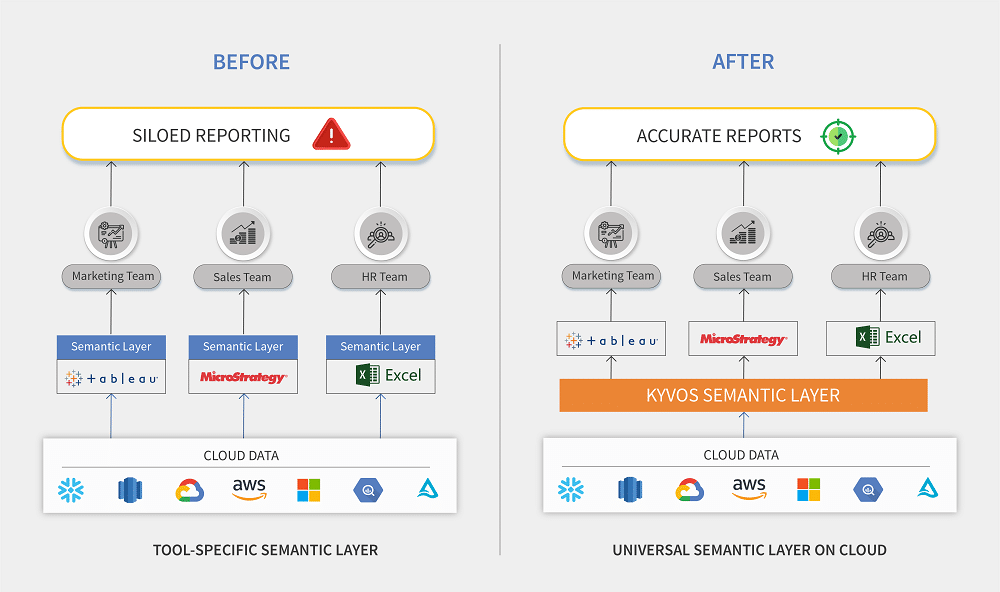5 Advantages of a Universal Semantic Layer for Cloud Analytics
When navigating bulky – and often complex enterprise data, organizations need more clarity, consistency, and uniformity in its interpretation to establish a single version of the truth. A universal semantic layer can solve this problem as a BI tool-agnostic abstraction layer providing simplified business terms for complex data.
The semantic layers have been around for some time now, and each BI tool has its own version. But, with rising data volumes and complexities, business users found it difficult to deal with multiple versions of business terms offered by each platform. Different data interpretations lead to delayed and skewed decision-making.
A well-defined semantic layer architecture provides a consistent view to interpret data and map it into familiar terms that users across the enterprise can understand with ease and use with confidence in its integrity. Here are some benefits it brings to modern data analytics:
Establish a Single Source of Truth
A semantic layer adds business language on top of the data layer to bridge the gap between data lingo and business vernacular. This is done by centralizing and standardizing the business logic while analyzing years of historical data.
Implementing DRY principles across the data and BI stack, the layer helps track business metrics and represent them in a language that all stakeholders can understand. Even when different users ask similar questions, the results will be consistent, fast, and accurate.
An ideal universal semantic data layer sits on top of all data sources and simplifies business meaning for both structured and unstructured data.
Enable Self-Serve BI Environment
With inbuilt self-serve capabilities, BI tools simplify data consumption and minimize the reliance of business users on IT teams to make sense of complicated data. Though, the process is impacted by inconsistency in data interpretation, security challenges posed by disparate data silos, and dependence on relational data models.
A BI semantic layer helps create a truly self-serve environment by allowing data parsing at the source to present information as familiar business terms. It can support all querying languages like SQL, DAX, and MDX, allowing users to query raw data using preferred BI tools.
Simplify Analytics
The semantic layer simplifies the user’s interaction with data and makes it easy to identify the areas they want to explore. Fields that need to be exposed to the business users are identified and given meaningful names that make sense to these users.
The dimensions, the measures, and the hierarchies are defined centrally. Users can then drag and drop these dimensions and measures in their charts and reports without worrying about the complexity of the underlying data.
Ensure Data Governance and Security
With data proliferating, organizations need to protect this information from unauthorized access, even from people inside the firewall. One way is to add protection layers at all entry levels for every user, although it could get messy and unorganized. A viable solution is to implement a single layer that sits above all data and provides secure access, be it cloud or on-prem storage systems.
A universal semantic layer becomes your guardrail for every analytical query fired by the users and ensures granular access control through column-level and row-level security for all users and user groups. It acts as a central governance gateway across your enterprise, enabling a consistent data view across all queries.
Enables High BI Performance
While dealing with massive amounts of data (increasing by leaps and bounds), organizations need a smart solution that not only caters to current needs but also accommodates future demands. The scale and complexity of this data may make analytics more challenging.
With a successfully deployed semantic layer, teams (business users, IT experts, or BI specialists) can fully trust their data and apply it to any use case to get instant answers. It reduces latencies and makes data landing in your CDWs or on-prem system query-ready within minutes. A semantic model eases the physical complexities by pre-aggregating it and optimizes BI performance across measures and dimensions without any data movement.
Looking Ahead
A universal semantic layer can help improve the BI ecosystem in more ways than anyone can anticipate. Organizations can add it as an extension to their BI architecture, simplifying it for faster, deeper, and more accurate analytics.
























